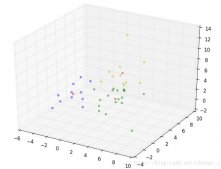tf.gather和gather_nd從params中收集數(shù)值,tf.scatter_nd 和 tf.scatter_nd_update用updates更新某一張量。嚴(yán)格上說,tf.gather_nd和tf.scatter_nd_update互為逆操作。
已知數(shù)值的位置,從張量中提取數(shù)值:tf.gather, tf.gather_nd
tf.gather indices每個(gè)元素(標(biāo)量)是params某個(gè)axis的索引,tf.gather_nd 中indices最后一個(gè)階對(duì)應(yīng)于索引值。
tf.gather函數(shù)
函數(shù)原型
|
1
2
3
4
5
6
7
|
gather( params, indices, validate_indices=None, name=None, axis=0) |
params是要查找的張量,indices是要查找值的索引(int32或int64),axis是查找軸,name是操作名。
如果indices是標(biāo)量

如果indices是向量

如果indices是高階張量

返回值:
該函數(shù)返回值類型與params相同,具體值是從params中收集過來的,形狀為

tf.gather_nd函數(shù)
函數(shù)原型
|
1
2
3
4
5
|
gather_nd( params, indices, name=None) |
indices是K階張量,包含K-1階的索引值。它最后一階是索引,最后一階維度必須小于等于params的秩。indices最后一階的維數(shù)等于params的秩時(shí),我們得到params的某些元素;indices最后一階的維數(shù)小于params的秩時(shí),我們得到params的切片。

輸出張量的形狀由indices的K-1階和params索引到的形狀拼接而成,如下面
|
1
|
indices.shape[:-1] + params.shape[indices.shape[-1]:] |
參數(shù):
params:被收集的張量。
indices:索引張量。必須是以下類型之一:int32,int64。
name:操作的名稱(可選)。
返回值:
該函數(shù)返回一個(gè)張量.與params具有相同的類型。張量值從indices所給定的索引中收集,并且具有這樣的形狀:

已知賦值的位置,向張量賦值:tf.scatter_nd, tf.scatter_nd_update
tf.scatter_nd對(duì)零張量進(jìn)行賦值,tf.scatter_nd_update對(duì)已有可變的張量進(jìn)行賦值。
|
1
2
3
4
5
6
7
|
tf.scatter_nd函數(shù)scatter_nd( indices, updates, shape, name=None) |
創(chuàng)建一個(gè)形狀為shape的零張量,將updates賦值到indices指定的位置。
indices是整數(shù)張量,最內(nèi)部維度對(duì)應(yīng)于索引。
|
1
|
indices.shape[-1] <= shape.rank |
如果indices.shape[-1] = shape.rank,那么indices直接對(duì)應(yīng)到新張量的單個(gè)元素。如果indices.shape[-1] < shape.rank,那么indices中每個(gè)元素對(duì)新張量做切片操作。updates的形狀應(yīng)該如下所示
|
1
|
indices.shape[:-1] + shape[indices.shape[-1]:] |
如果我們要把形狀為(4,)的updates賦值給形狀為(8,)的零張量,如下圖所示。

我們需要這樣子做
|
1
2
3
4
5
6
|
indices = tf.constant([[4], [3], [1], [7]])updates = tf.constant([9, 10, 11, 12])shape = tf.constant([8])scatter = tf.scatter_nd(indices, updates, shape)with tf.Session() as sess: print(sess.run(scatter)) |
我們得到這樣子的張量
|
1
|
[0, 11, 0, 10, 9, 0, 0, 12] |
上面代碼中,indices的形狀是(4,1),updates的形狀是(4,),shape的形狀是(8,)。
|
1
|
indices.shape[:-1]+shape[indices.shape[-1]:] = (4,)+(,)=(4,) |
如果我們要在三階張量中插入兩個(gè)切片,如下圖所示,則應(yīng)該像下面代碼里所說的那樣子做。

|
1
2
3
4
5
6
7
8
9
|
indices = tf.constant([[0], [2]])updates = tf.constant([[[5, 5, 5, 5], [6, 6, 6, 6], [7, 7, 7, 7], [8, 8, 8, 8]], [[5, 5, 5, 5], [6, 6, 6, 6], [7, 7, 7, 7], [8, 8, 8, 8]]])shape = tf.constant([4, 4, 4])scatter = tf.scatter_nd(indices, updates, shape)with tf.Session() as sess: print(sess.run(scatter)) |
indices的形狀是(2,1),updates的形狀是(2,4,4),shape的形狀是(4,4,4)。
|
1
|
indices.shape[:-1]+shape[indices.shape[-1]:]=(2,)+(4,4)=(2,4,4) |
我們會(huì)得到這樣子的張量
|
1
2
3
4
|
[[[5, 5, 5, 5], [6, 6, 6, 6], [7, 7, 7, 7], [8, 8, 8, 8]], [[0, 0, 0, 0], [0, 0, 0, 0], [0, 0, 0, 0], [0, 0, 0, 0]], [[5, 5, 5, 5], [6, 6, 6, 6], [7, 7, 7, 7], [8, 8, 8, 8]], [[0, 0, 0, 0], [0, 0, 0, 0], [0, 0, 0, 0], [0, 0, 0, 0]]] |
函數(shù)參數(shù)
indices:Tensor;必須是以下類型之一:int32,int64;索引值張量。
updates:Tensor;分散到輸出的更新。
shape:Tensor;必須與indices具有相同的類型;1-d;得到的張量的形狀。
name:操作的名稱(可選)。
返回值
此函數(shù)返回一個(gè)Tensor,它與updates有相同的類型;一個(gè)有shape形狀的新張量,初始化值為0,部分值根據(jù)indices用updates進(jìn)行更新。
tf.scatter_nd_update函數(shù)
函數(shù)原型
|
1
2
3
4
5
6
7
|
scatter_nd_update( ref, indices, updates, use_locking=True, name=None) |
scatter_nd_update也是把updates里面的值根據(jù)indices賦值到另外一個(gè)張量中,與scatter_nd不同的是,它是賦值到ref。
ref是秩為P的張量,indices是秩為Q的張量。
indices是整數(shù)類型的張量,必須具有這樣的形狀 。
。
indices最內(nèi)部的維度對(duì)應(yīng)于ref的某個(gè)元素或切片。
updates的形狀是 ,是秩為Q-1+P-K的張量。
,是秩為Q-1+P-K的張量。
如果我們想要把(4,)的向量賦值到(8,)的ref中,我們可以像下面這樣子操作。
|
1
2
3
4
5
6
|
ref = tf.Variable([1, 2, 3, 4, 5, 6, 7, 8])indices = tf.constant([[4], [3], [1] ,[7]])updates = tf.constant([9, 10, 11, 12])update = tf.scatter_nd_update(ref, indices, updates)with tf.Session() as sess: print sess.run(update) |
我們可以得到這樣的ref
|
1
|
[1, 11, 3, 10, 9, 6, 7, 12] |
函數(shù)參數(shù)
ref:一個(gè)可變的Tensor。
indices:一個(gè) int32 或 int64 Tensor;一個(gè)對(duì)ref進(jìn)行索引的張量.
updates:一個(gè)Tensor.必須與ref具有相同的類型;更新值張量.
use_locking:可選的bool;如果為True,則賦值將受鎖定的保護(hù);否則行為是不確定的,但可能表現(xiàn)出較少的爭(zhēng)用.
name:操作的名稱(可選).
返回值:
經(jīng)過更新的ref。
以上這篇淺談tensorflow中張量的提取值和賦值就是小編分享給大家的全部?jī)?nèi)容了,希望能給大家一個(gè)參考,也希望大家多多支持服務(wù)器之家。
原文鏈接:https://blog.csdn.net/chr1991/article/details/93474638












